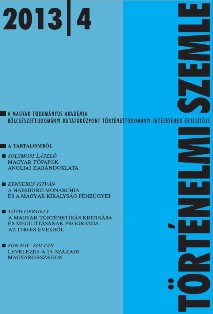A Habsburg Monarchia és a Magyar Királyság pénzügyei és hadi költségei a 16. század közepétől a 17. század első harmadáig
The Finances and Military Expenses of the Habsburg Monarchy and Hungary from the Middle of the 16th Century to the First Third of the 17th Century
Author(s): István KenyeresSubject(s): History
Published by: Magyar Tudományos Akadémia Bölcsészettudományi Kutatóközpont Történettudományi Intézet
Summary/Abstract: The aim of the present study is to examine the system of financing the anti-Ottoman military efforts of the Habsburg Monarchy as well as the revenues and contribution of the Hungarian Kingdom to these military expenses from the 1540s to 1640. Thanks to the financial reforms introduced by the Habsburgs and to the customs yields stemming from the flourishing cattle trade, the income of the Hungarian Kingdom had risen by the 1570s and 1580s to around 800 000 Rhenish florins (Rheinischer Gulden) p. a. Since the annual revenues of the Habsburg Monarchy were in the region between 2 and 2.5 million Rhenish florins in the second half of the 16th century, the money coming from Hungary amounted to at least a quarter, or even a third, of the Monarchy’s income. In the first third of the 17th century the Hungarian income can be estimated to somewhere between 530–550 000 and 600–800 000 Rhenish fl orins p. a. Although thus the incoming sums were considerable, the need for money of the Hungarian and Croatian border defense system established against the Ottomans increased constantly: from half a million florins in the 1540s to one million in the late 1550s and then to one and a half million by the long Ottoman war („Fifteen Years War”, 1592/93–1606), to which should be added some half million p. a. spent on the maintenance of castles and the provision of artillery and other military equipment. On the actual payment of military expenses very few data have been published so far. The present study thus presents those sources which shed light on the actual military disbursements. The accounts of the courtly paymaster (Hofzahlmeister) who fi nanced the costs of the common court of the monarchy, which have survived in an unbroken series from 1543 on, prove that the expenses of the anti-Ottoman defense – from an annual 200– 300 000 florins to as much as one million – were disbursed until the late 1550s through the courtly cash-desk. The office of military paymaster, which was established from the 1550s, took over from the 1560s and 1570s the charge of financing the system of border castles. In the case of the most important office, that of the military paymaster of the court (Kriegszahlmeister in Ungarn, Hofkriegszahlmeister), the accounts for 1570, 1610 and 1623 have come down to us, whereas the accounts of the military paymaster of Upper Hungary (Kriegszahlmeister in Oberungarn) are extant from 1569 and from the period between 1594 and 1601. On the basis of these accounts the overall sum paid on military expenses in the 1570s and 1580s must have been somewhere between one and one and a half million florins. These expenses rose to some five million p. a. by the period of the Fifteen Years War, to which should be added another half million for the costs of the court. As the Habsburgs could dispose of some 4–4.8 million florins, coming from the ordinary and extraordinary taxes levied in their countri
Journal: Történelmi Szemle
- Issue Year: 2013
- Issue No: 04
- Page Range: 541-568
- Page Count: 28
- Language: Hungarian

